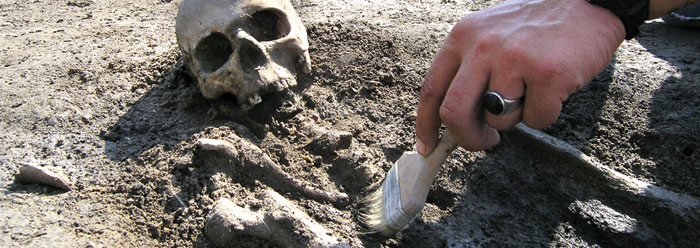An unexpected report has recently surfaced of a successful and sophisticated Stone-Age amputation.1 In an early tomb found south of Paris, France, scientists uncovered the remains of a man who was missing an arm. Their examinations revealed that it had been cut off just above the elbow and had healed over, indicating that he lived for perhaps several years following the successful surgery.
The Times reported that “the patient seems to have been anaesthetised, the conditions were aseptic, the cut was clean and the wound was treated.”1 The technical report was published in the journal Antiquity.2
ICR News has reported several finds indicating that Stone Age people were surprisingly modern in their knowledge and accoutrements, including Stone-Age jewelry and makeup, and high strength glue and stone knives from even earlier in man’s history.3 This most recent discovery adds further evidence of their sophistication—not only did Stone Age people know how to accessorize, but according to archaeologist Cécile Buquet-Marcon, “they obviously had medical knowledge.”1
Near this most recent discovery, a dredging operation periodically brings up Ice Age artifacts from the seafloor, including mammoth remains. Today’s North Sea bed was probably dry land during the Ice Age, which lasted for several hundred years after the Flood of Noah’s time. The immediate post-Flood seashores are roughly indicated by the continental shelf margins, which are easily seen online with Google maps satellite view. After the ice melted, sea levels rose and separated England from Europe.4
But for a time, people migrated into what was then a lowland. Tooled bones and hand axes have been found there.5 So, although the earliest European inhabitants had not yet had time to produce sophisticated technologies, once again science has learned that “they were more developed than previously thought.”1
If the first humans were specially fashioned by God, then it would be expected that archaeological artifacts would reflect the fact that humans have always had the abilities that can be observed in modern people. The more evidence that is uncovered, the more clear it becomes that mankind has been fully human from the very beginning.
References
- Sage, A. Evidence of Stone Age amputation forces rethink over history of surgery. The Times. Posted on timesonline.co.uk January 25, 2010, accessed January 26, 2010.
- Buquet-Marcon, C., P. Charlier and A. Samzun, 2009. A possible Early Neolithic amputation at Buthiers-Boulancourt (Seine-et-Marne), France. Antiquity. 83 (322).
- Thomas, B. Boats and Jewelry: ‘Stone Age’ People Were Surprisingly Modern. ICR News. Posted on icr.org January 25, 2010, accessed January 26, 2010; and Thomas, B. Ancient Stone Knives Made by ‘Smart’ Humans. ICR News. Posted on August 24, 2009, accessed January 29, 2010.
- Morris, J. 2009. The Ice Age: Causes and Consequences. Acts & Facts. 38 (8): 15.
- Kennedy, M. Stone age bones and axes found off Norfolk coast. The Guardian. Posted on guardian.co.uk March 10, 2008, accessed January 26, 2010.
* Mr. Thomas is Science Writer at the Institute for Creation Research.
Article posted on February 4, 2010.


















